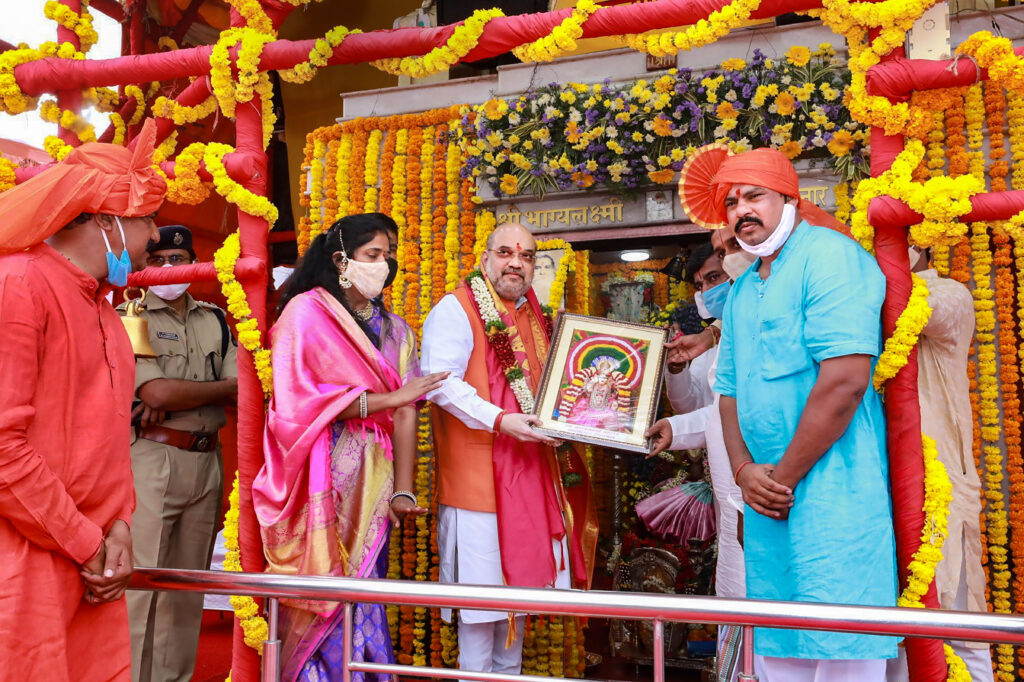Hyderabad: The encroachments in and around Charminar and their removal have been hotly debated by heritage activists. There are reports that it is due to these very structures that the monument, a symbol of Hyderabad, has lost its bid to be on the prestigious UNESCO World Heritage Site list.
It is against this backdrop that a new Right to Information has sought clarity on the subject – whether the Bhagyalakshmi Temple and the chilla (a Muslim religious flag like structure) are authorized structures or not.
The RTI questions were framed and sent by you RTI.in which is a forum that is working towards popularising the RTI as a tool. The questions were: when said temple and chilla were constructed, and whether these structures have been ‘legalised’ by way of recognition by the Archaeological Survey of India (ASI), or not.
The ASI is the foremost government agency which is engaged in conservation of monuments. Its Hyderabad Circle lists the Golconda Fort and the Charminar as under its purview. As a reply, the ASI wrote, “Bhagyalakshmi Temple came into existence after taking over of Hyderabad by Govt. of India adjacent to South Eastern Minaret of the Centrally Protected Monument. No records are available in this office about the Chilla adjacent to Charminar.”

This throws a great deal of light on the issue of legality of both structures, the temple more than the other. For decades, the area has been a flashpoint of communal activity and show of one-upmanship. While there were political undertones pinned to the temple, this became abundantly visible ahead of the Greater Hyderabad Municipal Corporation elections.
It was in 2012, that The Hindu, a leading English daily, published two photographs of Charminar. The first photograph was 60 years old. The second, was more recent. “Contrary to the claims by Hindu groups, an old photograph available with The Hindu shows that the contentious temple dedicated to goddess Bhagyalakshmi is not as old as the Charminar.
There is no date stamp on the photograph, but from the presence of the cars, it can be inferred that the photograph was taken about 60 years ago. No temple structure is visible in the picture,” The Hindu news report reads, adding that the temple is ‘a few decades old’.
The next day, the Times of India carried a story which quoted individuals making a case for the existence of the temple.
There was unrest over rumours of an alleged expansion of the temple. Police booked 18 cases after violence was reported in several parts of the Old City. According to a report, carried on November 12 the same year, there were rumours that the temple administration was allegedly trying to expand the structure.
One of the persons attempting to document the issue by means of the RTI Act is S Q Masood. A social activist, Masood says that the ASI tried on several occasions to get the temple removed. It wrote to the relevant authorities which did precious little to bell the cat.
“There were at least two letters written by different superintending archaeologists of the ASI demanding removal of the temple. One was in 1968 and the other was in 1977. According to documents which I have got from the ASI, it seems that not much came out of this. One of these implores the eviction of a pujari of the temple who had encroached the area,” Masood told siasat.com.
While that may be the case, Masood draws attention to another aspect. He says that as per an RTI question he had filed in 2012, the ASI clearly stated that the temple is an unauthorised structure.
Cut to recent times, the temple gained prominence in the GHMC elections which several leaders cutting across party lines paying visits. None other than India’s Home Minister Amit Shah visited the temple. Bharatiya Janata Party’s Telangana President Bandi Sanjay Kumar too waded in, sharpening the political and communal rhetoric. Delhi BJP’s leader Kapil Mishra, whose role ahead of the Delhi riots is suspect, too made an entrance. The attempt is to polarise the electorate.
But political rhetoric aside, it appears that attempts to protect the structure have had an undesired consequence. The Charminar Pedestrianisation Project sought to protect the monument by minimising vehicular activity around the structure.
Before the project kicked off, vehicular activity kept the spreading out of temple devotees in check. But, after the completion of the project, it appears that the temple, to quite an extent, has got a free run, at least in terms of devotee’s movement.
Large numbers have been gathering at the temple spreading over large portions of the pedestrianised area, scenes hitherto not witnessed. A cursory observation during festival season illustrates the point.

